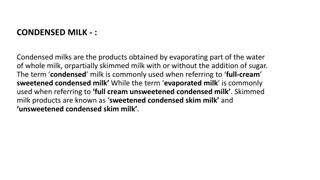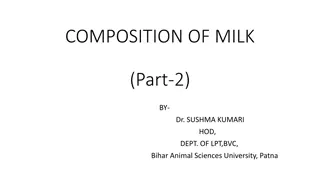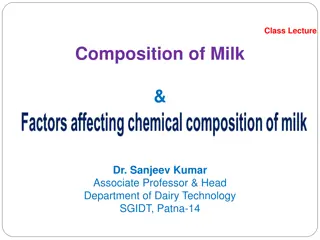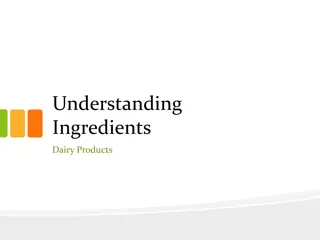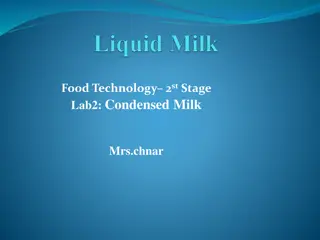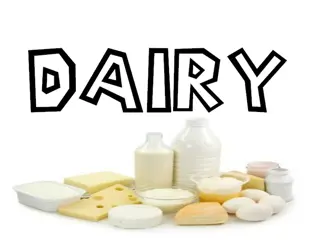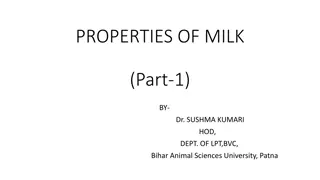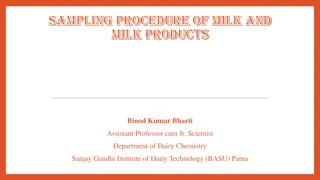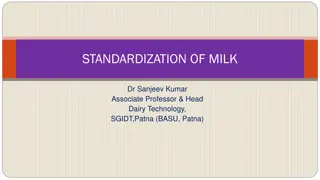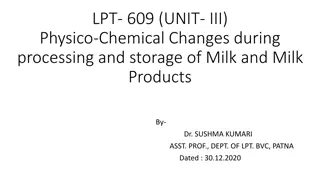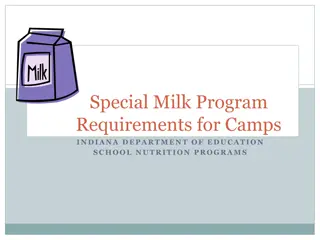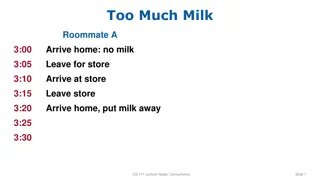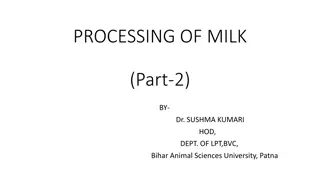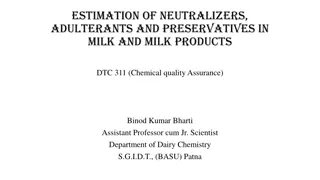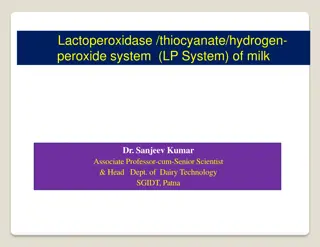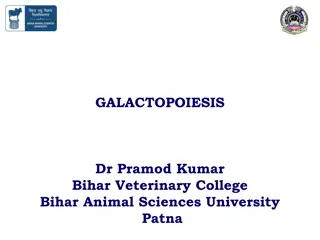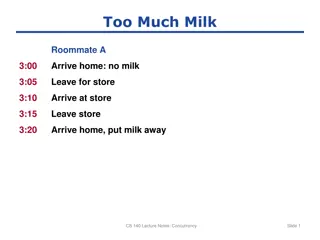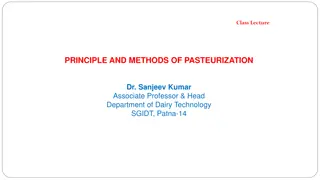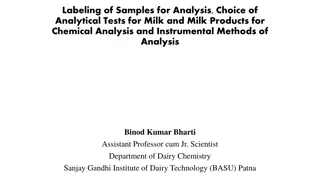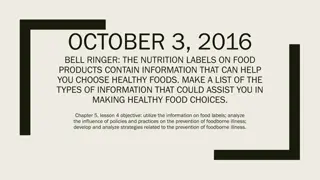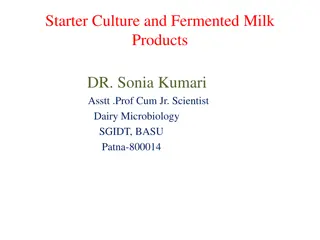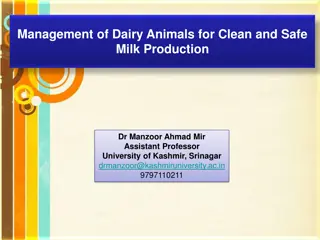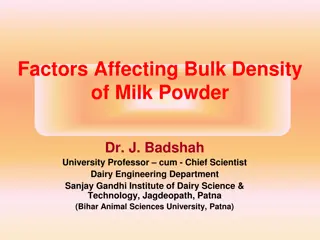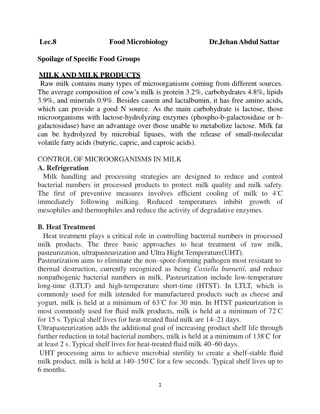Exploring Milk Ingredients as Nutraceuticals in Food Technology
Milk, known as nature's perfect food, contains bioactive components that have gained attention for their health benefits. Nutraceuticals derived from milk offer medical advantages beyond basic nutrition, aiding in disease prevention. Various minor milk components like lactoferrin and conjugated linoleic acid provide unique health benefits. Functional dairy foods and nutraceuticals, such as probiotics and whey proteins, offer anti-cancer and anti-bacterial properties. Understanding these components is crucial in the field of Food Technology.
Download Presentation

Please find below an Image/Link to download the presentation.
The content on the website is provided AS IS for your information and personal use only. It may not be sold, licensed, or shared on other websites without obtaining consent from the author. Download presentation by click this link. If you encounter any issues during the download, it is possible that the publisher has removed the file from their server.
E N D
Presentation Transcript
MILK INGREDIENTS AS NUTRACEUTICALS Department : Dairy Technology Course Title : Food Technology I Course No. : DTT -322 Course Teacher: Bipin Kumar Singh
Milk Components Milk is considered as nature"s perfect food, that besides meeting the nutritional requirements for the people of all ages also possess wide array of bioactive components. In recent years nutraceuticals and bioactive molecules present in milk have attracted a lot of attention from researchers, nutritionist, medical practitioners, and consumers alike. Since time immemorial, dairy products have been an integral part of human diet.
Nutraceutical Nutraceutical product is a food or fortified food product that not only supplements the diet but also assists in treating or preventing disease (apart fromanemia), so providesmedical benefits. Nutraceuticals or functional foods are foods that provide both health benefits to reduce the risk of chronic diseases and basic nutrition. Examples of nutraceuticals including antioxidants, dietary supplements, fortified dairy products, and citrus fruits, and vitamins, minerals, herbals, milk, and cereals. are natural foods,
Several health attributes are associated with milk or its constituents. Role ofcalcium in controlling hypertension and colon cancer Protective role of carotenoids and conjugated Linoleic acid (CLA) against cancers Butyric acid, the short chain fatty acid has been shown to regulate cell growth and enhance theantitumor activities
Minor Milk Components Certain minor milk components either naturally occurring or formed during processing have also been endowed with many unique health benefits. Examples include lactoferrin, lactulose, galacto-oligosaccharides (GOS), conjugated linoleic acid (CLA), - lactoglobulin, and bioactive peptides. Some of the important classes of functional dairy foods and nutraceuticals are listed below:
Examples of functional components in milk and milk products Class/Components Source Potential Benefit Probiotics Fatty Acids Conjugated Linoleic Fat rich dairy products, fermented milk products Anti-cancer, Anti-atherosclerosis and antidiabetics Acid (CLA) Whey Proteins -Lactoglobulin Milk, Whey Enhanced synthesis of glutathione, a natural antioxidant Lactoferrin Whey, Colostrums Anti-bacterial, increase bioavailability of iron Prebiotics Lactulose Heated milks, Synthesized from lactose Bifidogenic factor, improve GIT conditions in infants, laxative, prevent allergy
Galacto-oligosaccharides Fermented foods, Promote anticancer, increase mineral bioavailability growth of probiotic bacteria, (GOS) Galactosyltransferase activity of microbes Bioactive Peptides from Milk Proteins Caseino- Fermented milks, Proteolysis of casein inGI tract Mineral binding specially calcium phosphopeptides (CPP) Casomorphins Proteolysis of & -casein Increased absorption,increasedGI transittimes intestinal water & electrolyte Comparative presentation of various milk protein fractions i Protein fractions Concentration in milk Buffalo Cow -s1 Casein (g/100 ml) 1.44 -1.8 1.0 -s2 Casein (g/100 ml) 0.22 0.28 0.26 -Casein (g/100 ml) 1.26 -1.58 0.93
-Casein (g/100 ml) 0.43 - 0.54 0.33 -Lactoglobulin (mg/100 ml) 0.39 0.32 -Lactalbumin (mg/100 ml) 0.14 0.12 Lactoferrin (mg /L) 5 32 5 28 Bovine Serum Albumin (mg/100 ml) 29 40 Immunoglobulins (mg/100 ml) 9.8 38 172 220 Proteose-peptone ( g/100 ml)
Bioactive peptides as therapeutic components Peptides with opoid activity Peptides with Angiotensin I-converting enzyme inhibition activity Anti-thrombotic peptides Antimicrobial peptid Mineral binding peptides
Probiotic Microorganisms Lactobacillus Spp. Bifidobacterium spp. Other Lactic Other Species Acid Bacteria L. acidophilus B. adolescentis Enterococcus faecium Saccharomyces boulradii L. casei B. animalis E. faecalis Bacillus cereus L. cellobiosus B. longum Streptococcus thermophilus L. fermentum B. brevi L. lactis B. bifidum L. helveticus B. infantis L. reuteri B. lactis L. brevis L. plantarum L. curvatus
Mode of action of probiotics By direct interaction within the gut lumen with the complex ecosystem of the gut microbiota, they may produce substances like acids, CO2, H2O2 and bacteriocins that inhibit the growth of harmful microbes, By interaction with the gut mucus and the epithelium, inducing barrier effects, assist digestive processes, enhance mucosal immune and enteric nervoussystem; Through signaling to the host beyond the gut to the liver, systemic immune system, and other potential organs such as the brain.
Fortified Milk Products Milk also provides a convenient and useful vehicle for addition of certain nutrients to our diet and has following benefits: Easier quality control measure implementation Wider consumption byall age groups Cost is affordable bytarget population. Higher stability and bioavailability ofthe added micronutrients Addition of fortificants usually caused minimum change in colour, taste and appearance.
Fortification of milk & milk products with vitamins Under ambient conditions the water soluble vitamin C and vitamins of the B-complex group such as thiamin, riboflavin, vitamin B6, niacin, pantothenic acid, folic acid, biotin and vitamin B12 are powdered and thus relatively easy to add in milk and other dairy products. The fat soluble vitamins which include vitamin A, D, E and K, exist either as an oil emulsion or as crystals, which may cause processing difficulties during the manufacture of certain fortified dairy products.
Fortification of milk and milk products with minerals Iron: ferrous sulfate Calcium: carbonate, phosphate, citrate, lactate and gluconate. In general, organic salts of calcium



